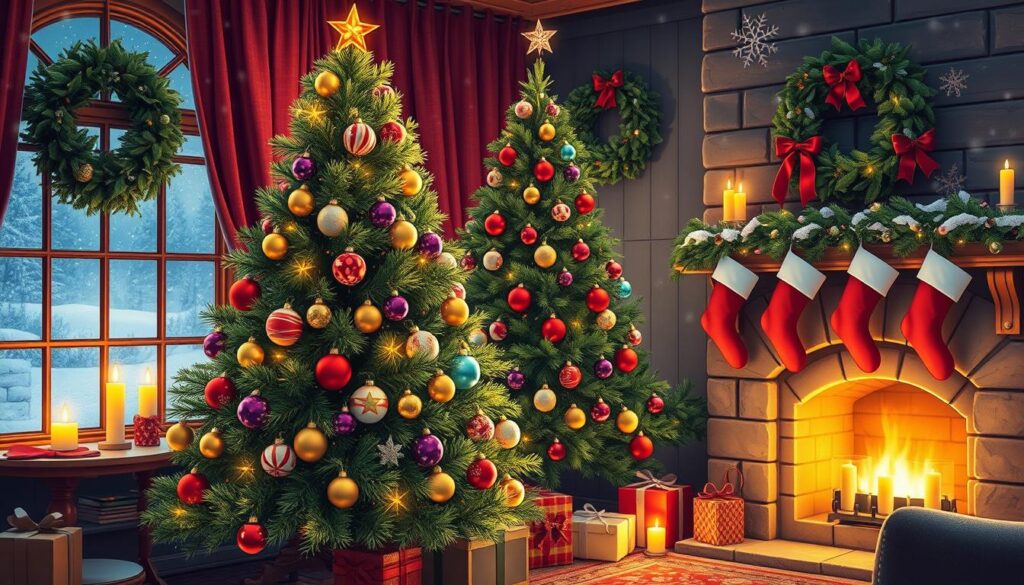Curious about the history and origins of the Christmas symbols we use to “deck the halls” each year? In a season filled with lights, colors, and traditions that have been cherished for centuries, the symbols woven throughout our décor infuse the festivities with timeless themes of love, hope, and faith. Let’s unwrap the stories and significance behind each of these beloved Christmas symbols, discovering the meaningful messages they carry.
Quick Overview
Light, Love, and Hope
Christmas Tree: The Christmas tree, often an evergreen like a spruce, fir, or pine, is a symbol of everlasting life with God. The triangular shape of the tree symbolizes the Holy Trinity (God, Jesus, and the Holy Spirit). The use of lights and ornaments on the tree symbolizes the light of Christ and the joy of the season.
The Nativity: The nativity scene brings the Christmas story to life through meaningful symbols. Each character represents an important aspect of the narrative. The humble setting reminds viewers of profound beginnings.
Star of Bethlehem: The Star of Bethlehem is the star that guided the three wise men to the birthplace of Jesus. It represents hope and peace, along with divine guidance and revelation.
Candles: A lit candle represents the Star of Bethlehem. Candles also symbolize the triumph of light over darkness, and they serve as a reminder that Jesus is the “Light of the World.” Before the advent of electricity, candles were often used on Christmas trees.
Angels: Angels are messengers of God who played an important role in the story of Jesus’ birth.
Legends and Life
Santa Claus: Santa Claus is based on St. Nicholas, a 4th-century bishop who was known for helping the poor and giving gifts. Santa Claus represents giving, kindness, and good will.
Reindeer: Reindeer represent safe journeying and endurance. They became part of the Christmas tradition after Clement Moore wrote the poem “A Visit from St. Nicholas.”
Wreath: A wreath is a circle with no beginning or end, symbolizing the strength of Jesus Christ’s love and the eternal nature of love. It also represents the circle of life, love, and rebirth. Christians believe that a wreath represents the crown of thorns worn by Jesus during his crucifixion.
Bells: The ringing of bells symbolizes the announcement of Jesus’ birth. The bell also means guidance and return, reminding people to return to the fold of Christianity.
Red and Green: The color red symbolizes the blood of Christ, and green symbolizes everlasting life.
Whimsy and Nature
Christmas Stocking: Based on the generosity story of Saint Nicholas, the use of stockings to represent gift giving and the magic of Christmas eve is a tradition that has endured for generations.
Candy Cane: The candy cane’s shape is said to represent a shepherd’s staff, which symbolizes the shepherds who were present at Jesus’ birth. Its red stripes are believed to represent the blood of Christ, and the white stripes symbolize purity and forgiveness.
Holly and Ivy: The pointed leaves of holly represent the crown of thorns placed on Jesus’ head at his crucifixion, and the berries represent the blood he shed. Holly remains green year-round, it also symbolizing immortality. Ivy is often intertwined with holly, symbolizing eternal life and faithfulness.
Mistletoe: Mistletoe represents love, friendship, and good will. In ancient times, it was believed to ward off evil spirits and bring good luck.
Poinsettia: The shape of the poinsettia resembles a star and is reminiscent of the Star of Bethlehem. Its red leaves symbolize the blood of Jesus, and its white leaves represent his purity.
Unraveling the Story of Christmas Symbols
The history of Christmas symbols is filled with tradition, belief, and cultural influence. Many of these symbols, like the Christmas tree and mistletoe have changed over time. While modern celebrations revolve around Christian themes, the origins of some of these symbols come from ancient rituals that were later adopted by Christianity. This mix of traditions has given us the rich and colorful symbols we love today.
The Christmas Tree: From Ancient Roots to Modern Tradition

From Ancient Winter Origins to Christian Tradition
The Christmas tree traces its origins back to ancient Northern Europe when people brought evergreen trees into their homes during winter. These early decorators believed greenery symbolized life, endurance, and hope during the darkest days of the year. The trees brought a touch of greenery and vitality to the cold winter months. Christians later adopted this tradition, transforming the evergreen into a symbol of everlasting life through faith.
German tradition transformed this practice in the 16th century when they began decorating fir trees with candles. The custom spread throughout Europe and reached American shores by the 19th century.
Decorating the Tree: Lights, Ornaments, and Their Meanings
The evolution of Christmas tree decorations mirrors personal, cultural, and technological progress. In the early days, trees were decorated with candles, fruit, and handmade ornaments. As the tradition grew, so did the variety of decorations. Glass ornaments were introduced in the 19th century adding elegance and sparkle. The invention of the electric light in the early 20th century revolutionized Christmas tree decorations, making them more vibrant and exciting. Today, Christmas tree decorations range from traditional to modern, offering many options to fit any taste.
Tree decorations have meanings that go beyond simple adornment. Lights symbolize the light of Christ. Garlands signify unity. Ornaments represent cherished memories, family histories, or beloved holiday customs. The artistry of Christmas ornaments, whether hand-painted, carved, or crafted from various materials by adults or children, are unique works of art that add to the tree’s beauty and charm. Families decorate their trees with love, adding to the warmth and magic of the holiday season while honoring tradition and personal milestones.
The Christmas tree is a lasting symbol of the holiday season. Its evolution shows how culture and technology have shaped our celebrations. From its ancient pagan roots to today, the Christmas tree brings joy to people worldwide.
The Nativity Scene: Christmas Story in Symbols
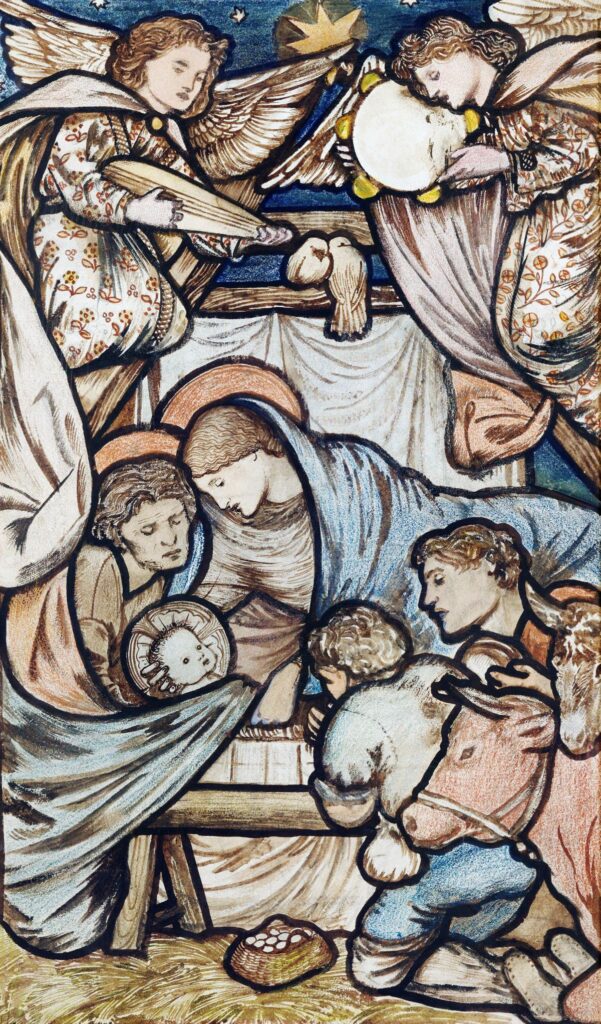
The nativity scene tells the story of Jesus’s birth in a beautiful way. The characters and setting of the nativity scene are symbolic aspects of the narrative, from the stable’s simplicity to the Holy Family’s unity. At the center is baby Jesus, in a manger with Mary and Joseph. This image shows Jesus’s humble start and his divine role.
- The stable represents humility.
- The Holy Family reflects love and devotion.
- The shepherds, who first saw Jesus, remind us to approach the Nativity with humbleness and wonder.
- The three wise men, or Magi, with their gifts of gold, frankincense, and myrrh, show Jesus’s importance and his birth’s global impact.
- The animals, like the ox and donkey, represent the divine and earthly coming together in this special event.
- The star above the manger is a symbol of hope, guidance, and the divine intervention that brought Jesus into the world.
A Reminder to Reflect
The nativity scene encourages us to think deeply about Christmas. It reminds us of the importance of humility, faith, and wonder of this origin story. Looking at this scene, we feel a connection to a moment of great divine significance, where the sacred and ordinary meet, revealing the holiday’s true essence.
Modern displays range from simple to elaborate arrangements. They help people connect with the spiritual meaning of Christmas. Many families pass nativity scenes through generations as cherished heirlooms.
The Star of Bethlehem: A Beacon of Hope
The Star of Bethlehem has roots in the nativity story, guiding the Wise Men to the birthplace of Jesus. In the Gospel of Matthew, this bright star symbolized the arrival of a new king, bringing hope and anticipation. This Christmas symbol reminds us that there’s light even in our darkest moments. It speaks to those searching for direction and promises that brilliant, divine light is always present to guide us through life’s journey.
The Star’s Representation in Art and Decoration
The star shines brightly in Christmas art and decorations, from tree toppers to outdoor displays. Artists often use the star to represent illumination and inspiration, bringing its light into festive designs. Whether it’s a simple ornament or a grand display, the star remains a cherished symbol, evoking wonder and faith.
Candles: Illuminating the Season
The use of candles at Christmas represent the Star of Bethlehem, bringing light to the darkness of winter. Each candle lit during the season recalls this guiding star, offering hope and peace. Candles add warmth and glow, creating a comforting atmosphere in homes and celebrations.
The Triumph of Light over Darkness
The theme of light triumphing over darkness is central to Christmas and many other winter holidays. Lighting candles is a way to celebrate hope and resilience, dispelling the cold. This tradition reminds us of the enduring power of faith and the promise of brighter days.
Candles in Religious and Secular Traditions
Candles are used in both religious and secular traditions, illuminating homes and gatherings. Their warm glow brings comfort, reminding us of togetherness and unity. Lighting candles during Christmas enhances the beauty of the season, filling hearts with joy and gratitude.
Angels: Heralding the Newborn King
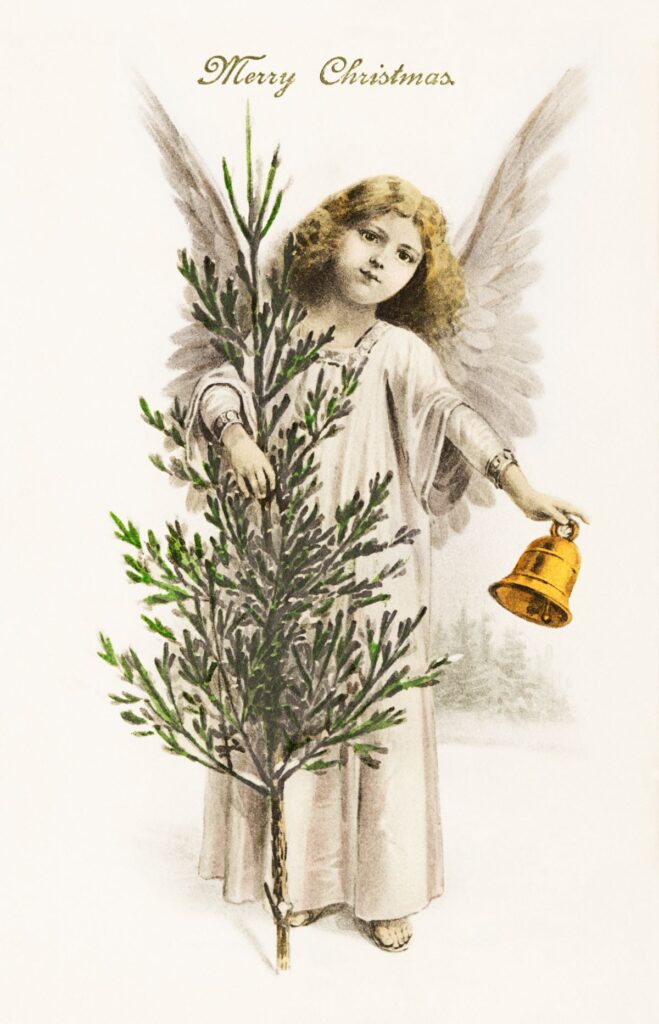
Angels have become an integral part of Christmas decorations, drawing from the Biblical account of angels announcing Christ’s birth to the shepherds. Typically portrayed in flowing white robes with wings and halos, these celestial figures often appear atop Christmas trees as a crowning ornament, symbolizing divine protection and guidance. Their traditional depiction with trumpets or harps recalls the heavenly hosts praising God in the nativity story, while their serene expressions and upward-gazing poses suggest a connection between heaven and earth.
Modern interpretations range from classically detailed porcelain figures to whimsical, child-like representations in materials like metal, glass, or fabric. Angels’ enduring presence in Christmas decor represents not only religious significance but also themes of peace, joy, and divine love, making them meaningful symbols for both religious and secular celebrations.
Santa Claus: The Jolly Symbol of Giving
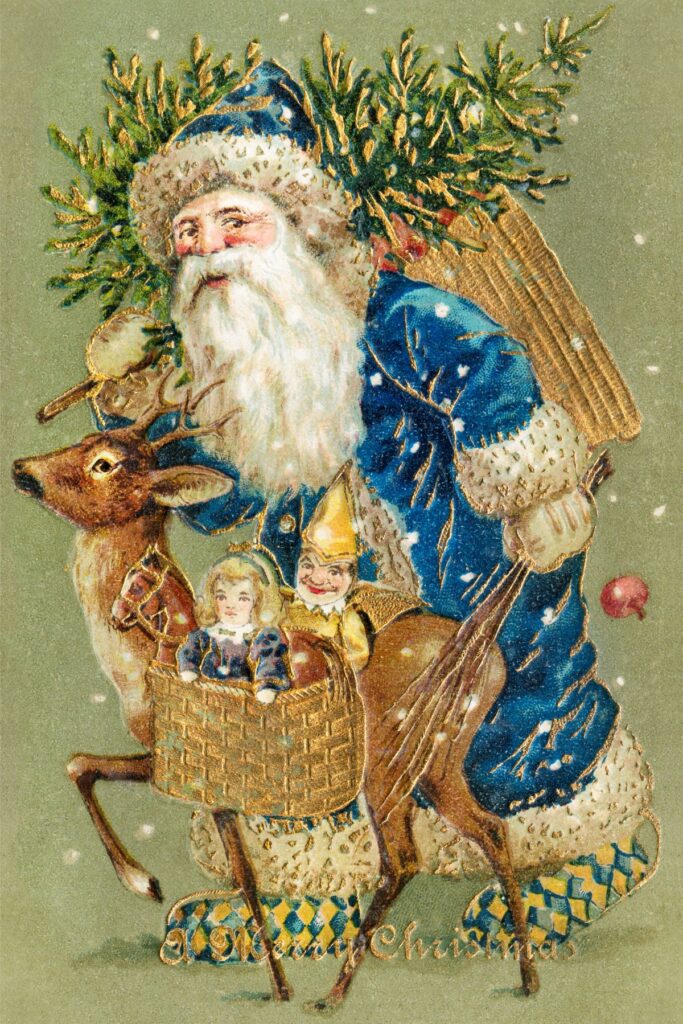
Santa Claus is a key figure in Christmas, known for his red suit and sack of gifts. His story begins with Saint Nicholas, a Christian bishop famous for his kindness.
The Historical Figure of Saint Nicholas: A Legacy of Generosity
Santa Claus originates from Saint Nicholas, a fourth-century bishop known for his generosity. This kind bishop became famous for giving gifts and helping those in need. Santa Claus has evolved from that charitable bishop to a global icon of Christmas cheer. From the red suit to his jolly laugh, Santa embodies the magic of the season. As a Christmas symbol, Santa represents the spirit and joy of giving, emphasizing the positive traits of kindness, compassion, and selflessness.
Reindeer: Guiding Santa’s Sleigh and Symbolizing Endurance
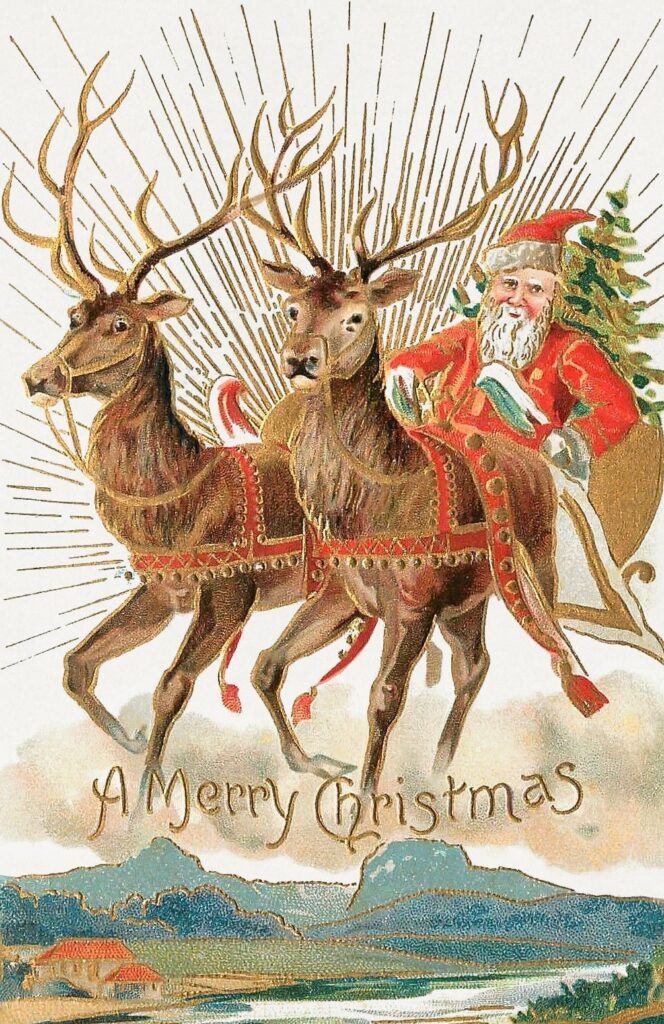
Reindeer are another beloved Christmas symbol with deep roots in Christmas lore and symbolism. Made famous as Santa Claus’s trusty sleigh team in Clement Moore’s 1823 poem, “A Visit from St. Nicholas,” reindeer have come to represent the adventure and excitement of Christmas Eve.
From Arctic Dwellers to Christmas Legends
Reindeer, native to the Arctic, became legendary for guiding Santa’s sleigh through snowy skies. These resilient animals symbolize strength and endurance, qualities that inspire us during the holiday season. Their transformation into Christmas symbols adds to the magic and wonder of Santa’s journey.
Reindeer’s Association with Safe Travels and Resilience
Reindeer have also come to symbolize safe travels and resilience, faithfully leading Santa on his mission. Their persistent nature reminds us to embrace challenges with strength. These timeless themes add an element of adventure and courage to holiday tales.
The Christmas Wreath: A Circle of Endless Love
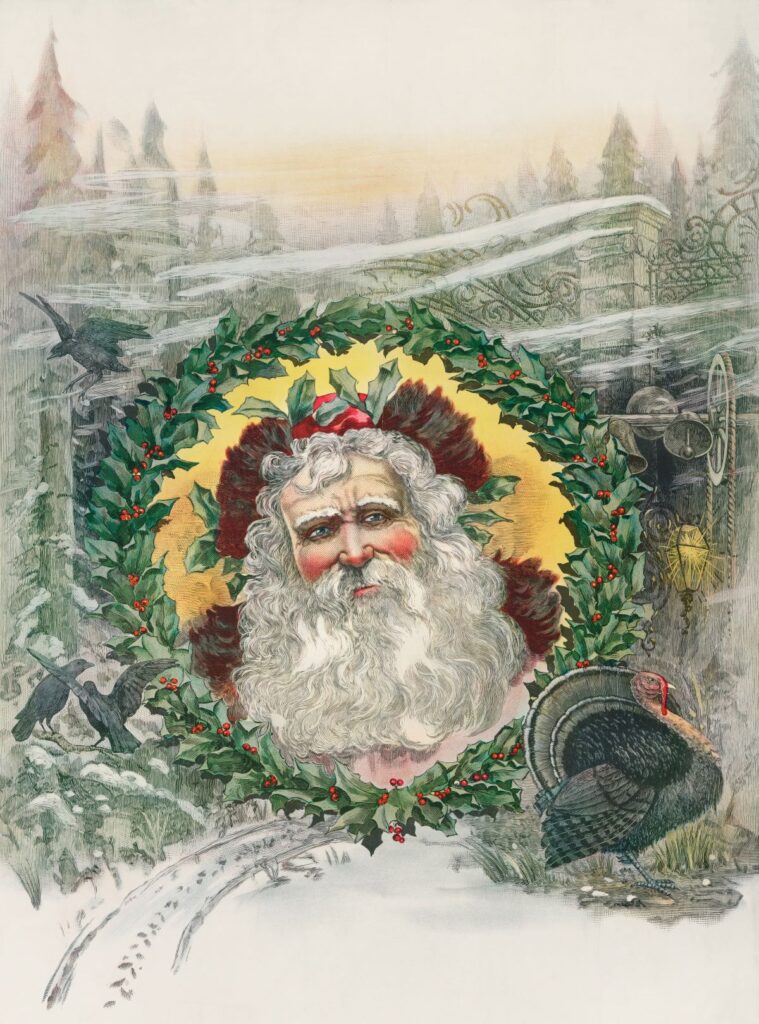
Wreaths trace their origins to ancient Rome, where people wore them as symbols of victory. The circular shape and evergreen foliage symbolize unity, continuity, God’s unending love, and the continuous cycle of seasons. Displaying wreaths on doors and walls celebrates love and eternity, bringing warmth into homes. Many families maintain traditions of hanging wreaths to share holiday spirit.
Ideas for Creating a Wreath-Making Tradition
Why not add a wreath-making activity to your holiday traditions? Making wreaths allows people show their creativity and personal style. From classic evergreen wreaths with red bows to modern ones with unique materials and designs, this is a fun way to celebrate the season. Here are some unique ideas for wreaths.
Family Story Wreath
- Each family member contributes one special item
- Include small mementos from the year’s events
- Add dated ornaments or trinkets
- Write notes about each item’s significance
- Display prominently and document the story
Generation Wreaths
- Pass down special decorative elements
- Include heirloom ribbons or ornaments
- Create matching wreaths for extended family
- Take photos of multiple generations making wreaths together
- Start a tradition of gifting wreaths to new family members
Memorial Wreaths
- Honor loved ones with their favorite colors or themes
- Include items that represent their interests
- Add dried flowers from special occasions
- Place at meaningful locations
- Create an annual ritual of hanging these wreaths
Children’s Traditions
- Create simplified wreaths with paper plates and natural items
- Make hand-printed leaf decorations
- String popcorn and cranberry garlands
- Tell stories while crafting
- Date and preserve children’s creations
- Share completed wreaths on social media
- Start a local wreath-making guild
Wreath Blessing or Ceremony
- Create a special ritual for hanging wreaths
- Write an annual dedication
- Light candles during creation
- Say prayers or wishes
- Document meaningful moments
Bells: Ringing in the Joy of Christmas
The Sound of Celebration: Announcing the Birth of Christ
Bells have long announced celebrations, marking the joyful news of Christ’s birth. Their ringing traditionally called people to worship and community gatherings, filling the air with excitement and wonder.
Bells as a Call to Return to Faith and a Symbol of Guidance
Bells often symbolize guidance and the call to return to faith. Their sound serves as a reminder of all things spiritual, inspiring hope and reconnecting people with matters of heart and soul.
From Church Services to Caroling: The Use of Bells in Christmas Traditions
Bells play a central role in Christmas traditions, from church services to caroling. Their lively chimes add a musical touch to festivities, enhancing the joy of gatherings. This cherished custom unites people, celebrating the spirit of Christmas through music and shared traditions.
The Colors Red and Green: The Hues of Christmas
Red: Representing the Blood of Christ and His Sacrifice
The color red in Christmas decorations symbolizes Christ’s sacrifice and divine love, adding depth to holiday traditions. This vibrant color speaks to courage, reminding us of the profound meaning behind Christmas. From decorations to clothing, red fills the season with warmth and significance. It appears in decorations from candy canes to ribbons and in festive clothing.
Green: The Color of Evergreens, Symbolizing Eternal Life and Hope
Green represents eternal life and hope, and is found in Christmas trees, garlands, and wreaths. This color’s presence speaks to endurance and renewal, qualities that resonate with the holiday spirit. Green reminds us that life continues, inspiring optimism for the future.
Christmas Stockings: Symbols of Service and Generosity
We can thank the legend of Saint Nicholas for another beloved Christmas symbol, the stocking. The story goes that Saint Nick, upon hearing of three daughters too poor for dowries, dropped bags of gold down their chimney. The gold landed in stockings hung by the fireplace to dry. Today, Christmas stockings are not only a symbol of generous and joyful giving, but they also extend a wish for good luck, abundance, and protection for the entire household during the Christmas season.
Creative Christmas Stocking Ideas
Incorporating the Christmas stocking tradition into holiday activities can be both fun and meaningful.
- One way is by creating a family “stocking stuffing night,” where each family member fills another’s stocking with handwritten notes, small treats, or handmade gifts to share gratitude and warm wishes.
- For those looking to encourage acts of kindness, try starting a “giving stocking” tradition by hanging an extra stocking by the fireplace where family members can place small donations or notes of kindness, to be shared with someone in need after the holidays.
- Making and decorating stockings together can be a creative bonding activity, allowing family members to personalize them with symbols, colors, and patterns that hold special meaning. While traditional red and green stockings are classic, making your own can be really You can add embroidery, hand-painting, or other designs. Here are some ideas to get you started:
- Monogrammed Stockings: Add your family’s initials or names for a personal touch.
- Themed Stockings: Pick a theme, like your favorite movies or characters, and make stockings that show your interests.
- Handmade Appliqués: Use festive shapes like snowflakes or reindeer to decorate your stockings.
- Painted Designs: Get creative with paints and make unique designs on your stockings.
The Candy Cane: A Sweet Treat with Symbolic Significance
The candy cane’s story begins in the17th century in Germany. Legend has it that in 1670, the iconic Christmas symbol was born when the choirmaster at the Cologne Cathedral handed out sugar sticks among his young singers to keep them quiet during the Christmas services. The story continues that because sweets were not considered appropriate as such a solemn occasion, the choirmaster bent the stick in the shape of a shepherd’s crook or a “J” for Jesus, thus adding a symbolic meaning.
Today, candy canes are a big part of Christmas, loved for their red and white stripes and peppermint taste. For those in the know, they also serve as a reminder of Christ as the Good Shepherd, guiding his flock, making them a delightful and meaningful holiday treat.
Holly and Ivy: Symbols of Sacrifice and Faithfulness
Holly’s Prickly Leaves and Red Berries: Reminders of Christ’s Passion
Holly, with its prickly leaves and red berries, symbolizes Christ’s suffering and sacrifice. The sharp leaves remind us of the crown of thorns, while the berries represent His blood. This powerful symbolism makes holly a fitting decoration, adding meaning to the greenery of Christmas.
Ivy’s Enduring Nature: A Symbol of Eternal Life and Devotion
Ivy, with its climbing nature, represents eternal life and faithfulness, often intertwined with holly in holiday decor. Its tenacious growth reminds us of devotion and the unbreakable bond of love. Together, holly and ivy are symbols of sacrifice and faith, giving Christmas greenery a rich meaning.
Mistletoe: The Kissing Tradition and Its Mythological Roots
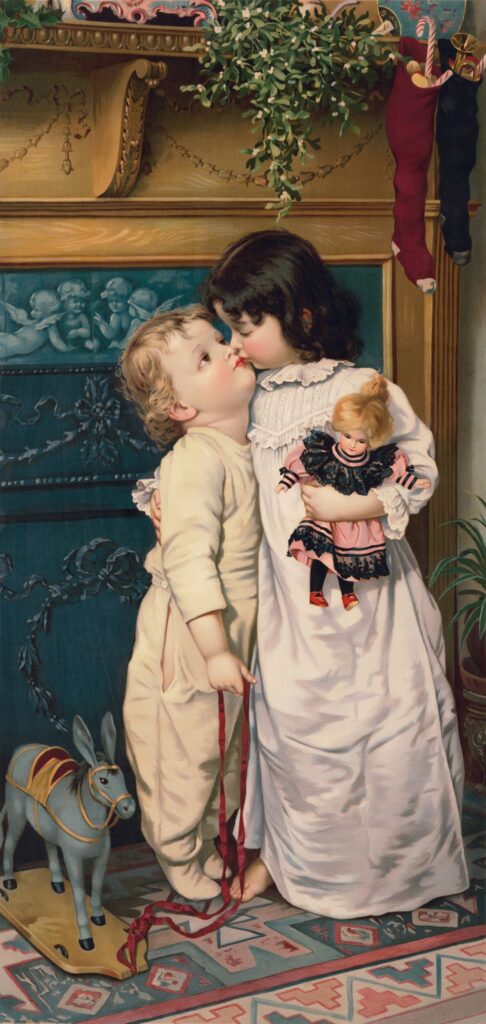
From Druid Lore to Romantic Christmas Ritual
In ancient Greek and Roman culture, mistletoe was used for its healing properties. During the Middle Ages, Celtic Druids believed it was a sacred plant that provided protection and restored fertility, and used it to announce the arrival of the New Year.
With its dark green leaves and white berries, mistletoe is not only a decorative accent during the Christmas season, but represents a romantic tradition that stems from Norse mythology. The goddess Frigg, following a quest to protect her son Baldr from harm, declared mistletoe a symbol of peace and love and that anyone who passed under it should get a kiss. This was a sign of friendship and forgiveness.
Mistletoe’s Symbolism of Love, Friendship, and Good Luck
Today mistletoe represents love, friendship, and good luck. Its place in holiday celebrations highlights themes of unity and affection. As people exchange kisses under the mistletoe, they honor an age-old tradition that generates warmth and connection.
The Poinsettia: Multi-Faceted Symbol of Humility and Miracles
The poinsettia has become one of Christmas’s most recognizable botanical symbols, its star-shaped leaf pattern said to represent the Star of Bethlehem that guided the Wise Men to the infant Jesus. The red bracts (colored leaves) are often interpreted as symbolizing the blood of Christ’s crucifixion, while the plant’s white flowers represent His purity.
The poinsettia gained its Christmas association through a Mexican legend of a poor child who, having no gift for the baby Jesus, gathered humble roadside weeds that miraculously transformed into brilliant crimson blooms when placed at the church altar. First introduced to the United States in the 1820s by Joel Roberts Poinsett, these vibrant plants now serve as a reminder of both humble gifts given with love and the miraculous nature of the Christmas season.
Conclusion: Embracing the Deeper Meaning of Christmas
Reflecting on the Symbolism and Significance of the Season
Christmas symbols connect us to centuries of celebration and meaning. They carry deep spiritual and cultural values that whisper to us across the generations. Use of these symbols reminds us of love, hope, and giving during the holiday season. Understanding the symbolism and incorporating them into our own modern traditions enriches our appreciation of the true meaning of Christmas.
Carrying the Spirit of Christmas Throughout the Year
The spirit of Christmas doesn’t have to end with the season. We can carry the messages of love, kindness, and hope with us all year long. By embracing the lessons of these timeless symbols, we foster joy, compassion, and connection in our lives and communities.
Enjoy this article? You may also like these:


